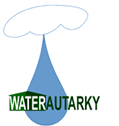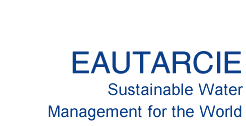
Purification using plants or phytopurification, including lagooning systems, is a process that is quite different from the TRAISELECT system’s wetland finishing stage. Phytopurification systems can only be justified when flush toilets are used. This therefore qualifies phytopurification as a conventional sanitation technique, and definitely not as an ecological sanitation technique.
The text within this page was first published in French on www.eautarcie.com:
in 2004
The original text has been adapted and translated in English by André Leguerrier and was first published on this page at www.eautarcie.org:
2009-06-15
Last update: 2016-06-27


The Problem with Phytopurification
Water purification techniques using plants (called phytopurification techniques) are lauded by environmentalists. Many of our correspondents request our assistance in implementing a phytopurification system for their household greywater. Yet they do not realize that greywater treatment is totally unnecessary: it is preferable to simply use greywater for watering their garden. Unfortunately, the bucolic view![]() of plants as THE water management solution hides a lesser reality.
of plants as THE water management solution hides a lesser reality.
Humus, dejecta and wastewater purification
To understand the real issues of phytopurification, you have to understand how continental ecosystems work. At the base of these, you find soil, within which you find humus. The soil is not only an inorganic support and a source of nutrients for plant roots. In fact, healthy plants live in a complex and symbiotic relationship with an extremely rich and varied soil life. Humus provides the necessary living space to harbour all of these. It is a brown organic matter of great complexity whose presence in the soil makes all the difference between fertile land and desert. It is justifiably called the « brown gold of the earth », for without it, life on continents could not evolve. Soil’s humus regulates soil moisture conditions by acting as a sponge. One gram of humus is able to store up to 50g of water, which is gradually made available to plants. Were it not for this special characteristic, precipitation would run off directly to water courses instead of being absorbed by the soil. As a result, you’ would be faced with problems such as soil erosion, flooding, droughts and diminishing groundwater levels. The following assertion may be surprising, but the majority of the world’s water problems are caused by the disappearance of humus due to human activities.
The general disinterest on this issue is disappointing, considering its importance for human survival on Earth: maintaining, or moreover restoring humus in soils. The dejecta of 7 billion human beings, of livestock and other animals are essential to maintaining humus in existing continental ecosystems. The non-renewal of this biomass in the cycle of soil formation is the starting point of said water problems, which should be seen as early-warning signs. Need we repeat: wastewater treatment, even using plants, constitutes a destruction of human biomass that leads to unbalanced ecosystems. Contrary to erroneously-based conventional wisdom, truly sustainable sanitation must not aim to better « protect human health » or « eliminate pollution »: it must aim to correctly return our dejecta’s organic matter in the cycle of humus formation for soils. This should be the motto of sanitary engineering schools.
Humus formation requires nitrogen-rich animal biomass (animal manure, liquid manure, urine, human dejecta) and carbon-rich plant biomass (cellulose, lignin and derivatives such as cardboard, paper, etc.). These two types of biomass need to be combined to form humus by means of different composting techniques (heap composting or ground surface composting, for soil fertilisation, regeneration and pollutant elimination, thermogenic composting, etc.). This is the starting point of a complex process that must respect strict conditions for humus to be formed. Of course, the biosphere’s adaptive capacity makes it possible for humus to be formed using other methods, centered on edaphic conditions (soil composition and structure) as well as climate conditions. These depend on the availability of local materials and manpower, and on the ultimate end-purpose of said techniques. Some errors are to be avoided. For example, it is a serious mistake to believe that humus can be formed by simply introducing organic matter in the soil. Phytopurification destroys precious animal biomass (contained in black water), transforming it into plant biomass at great cost (loss of matter and energy potential), thus creating a series of imbalances. Unfortunately, plants produced in this way cannot replace the proteinaceous molecular structures contained in human dejecta that have been destroyed in the process. In this sense, phytopurification is truly an environmental wastage.
Nature does not produce waste. Animal and human dejecta are not waste to be eliminated. They are part of the ecosystems that produce our food. As food comes from the earth, our excreta must inevitably return to the earth in form of stabilized humus to complete the natural cycle. This process does not occur when animal or human dejecta are treated/purified, either by conventional treatment or phytopurification. Such shameful wastage becomes absolute and irreversible. All dejecta (animal or human) that are purified in any way remove precious organic nitrogenous matter from the process of humus formation and ultimately produce water pollution by nitrates, and to a certain extent by phosphates.
Water treatment/purification, even when using plants, destroys and even deconstructs nitrogenous organic matter contained in dejecta. The attempt to have plants absorb the inorganic nitrogen resulting form this deconstruction short-circuits an annual cycle in the forming of humus, and eliminates the essential animal component in a composting process. For further reading on the importance of humus, go to text on the Ecological Sanitation page.
The purification efficiency of plants
Fundamentally, in nature, aquatic plants (and others) do play an important role in the purification and filtering of surface waters. More precisely, the bacteria that attach to or live in symbiosis with plants’ root systems are the ones that do most of the work. Plants absorb nitrates and phosphates from water. They can bind a whole series of pollutants, and even some heavy metals. Purification using plants is therefore the reproduction of a natural process that can be used to remediate polluted watercourses (as in « phytoremediation ») [1].
Limestones that come into contact with water containing humus and colloidal clay suspensions also clarify natural waters. In nature that is undisturbed by man, all water eventually gets purified by spontaneous processes. Here also, sunlight plays an important role, and is one of the factors involved in greywater treatment under EAUTARCIE’s version of ECOSAN (or SAINECO). Treated wastewater that is dumped into rivers by treatment plants causes many disruptions, the most spectacular of which is eutrophication. Spontaneous self-purification in rivers tends to repair the damage of such treatment. With the widespread use of mains sewerage and wastewater treatment, the self-purifying capacity of most of our rivers has already largely been exceeded. So much so that nitric nitrogen and phosphates from sewage are now polluting the seas[2].
Even if wastewater treatment (including the use of phytopurification) is not a sustainable sanitation technique, phytopurification can be temporarily used to help clean up polluted sediment sludge from the bottom of watercourses. For example, one can consider creating slow-flow wetlands at the confluence of great rivers that need a cleaning-up.
Prior to the implementation of the European wastewater treatment program that cost billions of Euros, Atlantic and North Sea beaches had practically no algae. Consider that chemically-based agriculture and the general use of pig slurry were already polluting farmland soils since at least 50 years before the onset of said program. Yet algae progressively appeared only after the wastewater treatment program began being implemented. Proponents of wastewater treatment attempted to mitigate public perception of the astronomical expenses of the program by promising to protect and improve the water quality in rivers and groundwaters. Nevertheless, after the program was fully implemented, the quality of groundwaters continued to decline, just as fast as before. Meanwhile, the average quality of rivers has decreased (except where wastewater treatment came to replace the massive dumping of raw untreated wastewater into rivers, near large cities).
At the Commission Gouvernementale des Eaux (or Governmental Water Commission), well before the launch of the wastewater treatment program, I drew attention to a series of facts, such as:
a) Rivers are mainly polluted by industrial water and the discharge of urban waters without treatment.
b) Groundwaters are polluted mainly by agriculture and livestock manure; agricultural pollution rarely ends up in rivers.
c) The overwhelming majority of wastewater from family homes (70% of housing in the Walloon Region) is infiltrated into the ground (1992) with absorption pits. Thus, nitrogen pollution from these habitats does not end up in rivers: it is largely purified by the soil. Ultimately, housing represents a very minor vector of nitrogen pollution of our groundwaters.
d) To channel this mass of wastewater into rivers via sewage treatment plants represents not only a huge expense, but will cause serious pollution of rivers (from residual pollutants discharged by treatment plants) and produce mountains of sewage sludge that it will be hard to get rid of without creating other environmental problems. Consequently, the implementation of the wastewater treatment program will not hold up to its promises. The water situation will worsen, despite huge expenses.
At the Water Commission, no one took me seriously, not even representatives of environmental protection associations.
In 1995, I suggested to the Commission that centralized sewerage not be implemented in rural areas, and that individual wastewater treatment, preferably selective treatment, be encouraged, including wastewater disperson into the ground, and that wastewater discharge into water bodies (treated and untreated wastewater) be avoided, if at all possible. I proposed that this strategy be extended also to those periurban/suburban areas with individual homes and gardens. In 1992, I had already proposed that greywater and blackwater be collected and treated separately. All of these measures could have saved the Walloon Region billions of Euros for sanitation and would have contributed to renewing the salmon population in the region’s rivers; not to mention keeping the North Sea beaches clean. Currently, millions of Euros are spent to remove algae from beaches.
When considering domestic wastewater management from the viewpoint of an « eco-friendly » sanitation engineer, phytopurification is perceived and promoted as a panacea, while ignoring the problems of conventional sanitation systems.
This (incorrect) view is based on the same principles that guide conventional treatment systems: purify as best as can be done, without other considerations or concerns for the environment.
The technical problems of phytopurification
Phytopurification is, in a sense, one and the same as conventional wastewater treatment, especially for an observer who prioritizes minimum environmental impact over maximum purification efficiency. The main differences: conventional wastewater treatment generates less water loss by evaporation whereas phytopurification produces less sewage sludge.
Another disadvantage of these systems is that they disregard concerns about preventing pollution at its source. When black water is removed from the equation (i.e. not produced), the notion of population-equivalent loses all meaning (see wastewater discharge standards). Prevention of pollution should be the main objective of any approach seeking to safeguard the environment. Wastewater purification is a corrective (instead of preventive) technique. Phytopurification systems are always designed as a solution to treat combined wastewater (black and grey). Now, when a flush toilet is NOT used, purification using plants is no longer necessary. Recycling greywater in one’s garden offers interesting possibilities.
Many environmentalists who live in suburbs regret not having enough space to install a phytopurification system such as a waste stabilization pond or a lagooning system. They don’t realize that the simple suppression of flush toilets from their home offers the possibility of implementing selective greywater treatment within a relatively small area of their garden.
A lagooning system or the use of planted filtration systems can give the illusion that aquatic plants take charge of the water that has been polluted by excreta. This assertion, while partly founded, is overall incorrect. The scientific reality is much more complex. Such overrating of phytopurification comes from the fact that it is assessed on the same basis as conventional sanitation, by simply measuring the system’s « purification efficiency » without regards for other environmental impacts.
Other environmental impacts
Phytopurified wastewater is essentially of the same quality as that which comes out of a conventional mechanical system (designed for nitrogen and phosphorus removal). It still contains too many nitrates and phosphates to be harmlessly dumped in a naturally clean river [3].
An efficient lagooning system still discharges about 10 milligrams of nitrogen (N) per litre into the receiving milieu. This is obviously little compared to the organic nitrogen that initially entered the system: the purification efficiency of the system is therefore good. Unfortunately, the discharge of even such a minimal amount of nitrogen (Remark: 10 mg of nitrogen N is equivalent to 44 mg of nitrate NO3-) in a river that has not suffered any domestic pollution (e.g. mountain streams in sensitive natural areas) generates an eutrophication process that can ultimately asphyxiate the stream. In such sensitive areas, a combined use of BLT's (BioLitter Toilets) and selective greywater treatment (by infiltration into the ground) are the only ways of efficiently protecting water bodies. Therefore, purification of black water using plants is a lure.
Plants however present one advantage, with regards to the sludge produced. There is less of it, and it is of a better quality than that of conventional mechanical systems, since part of the pollution is absorbed by the plants.
Water loss due to evaporation is another factor. This is especially important in hotter and drier climate zones. In North Africa, the Middle East and southern Europe for example, such water loss can attain 60 and even 80% of the initial water entering a system. That is unfortunate, in areas where agricultural yields are directly proportional to the available water for irrigation. Regrettably, as soon as wastewater contains black water, irrigation of food crops becomes problematical, even after proper treatment. Sanitation risks remain.
To persist in using plants for wastewater purification instead of adopting separate treatments of black water and greywater is all the more regrettable, whereby for black water, composting eliminates all « faecal hazards » [4], and all greywater produced by the household can be reclaimed for agricultural/gardening purposes. In addition, soil improvement obtained from direct composting of our excreta greatly increases the water holding capacity of soil, thus reducing the need for irrigation, chemical fertilizers and pesticides.
…as well as pharmaceutical residues that are present in black water, causing grave concerns in rivers. When black water is composted, these residues are eliminated.
In this context, one can only be astounded to find lagooning systems in the middle of the desert, where above-mentioned water loss attains 80 %. Even their proponents acknowledge that the residual 20% of treated water is not altogether safe for agricultural reuse, due to the presence of intestinal parasites (helminths). Against all common sense, these systems are implemented in Africa (Sahara) by internationally renowned specialists [5].
Ref. Mr De Winter, Épuration des eaux à Dakar (or Wastewater purification in Dakar). Dimension 3 [a review by the Administration Générale du Coopération au Développement or General Administration of Development Cooperation, currently named DGCD], N° 5, October-November 1994. Before the launch of the phytopurification program, I presented an alternative solution (which was not accepted) that would involve the widespread use of dry toilets, composting of dejecta to be used to regenerate the soils in this desert region, and the use of greywater for irrigation. The results could have been: a 25% reduction in water consumption (in a region where every litre of water is « worth its weight in gold »), the possibility of using all wastewater for crop irrigation, and an increase in the soil’s water-holding capacity through the use of composted dejecta (thereby reducing water requirements for irrigation). Be that as it may, after the implementation of phytopurification systems, it was observed that 80% of the water was lost by evaporation, and that treated wastewater was unusable for subsistance agriculture due to the presence of intestinal parasitic eggs. Result: wastewater totally « wasted », biomass from dejecta totally lost, and soils depleted. These are the true impacts of phytopurification.
Even in temperate zones, the area occupied by a phytopurification system is enormous when compared to selective greywater treatment. Its installation cost and maintenance and operations costs are equally important. A set-up for a family of 5 will require about 100 m² of terrain with a very specific topography. On the other hand, the same family, adopting one of the selective greywater treatment techniques described in the first chapter, will need much less garden space. Installation costs will also be lower.
Maintenance of a phytopurification system requires annual cutting of plants, their subsequent composting, regular removal and elimination of sludge deposit in the basins, plant replacement after 5 to 10 years. When replacing these (such as macrophytes), the system ceases to operate for many months, until the plants are mature.
In contrast, maintenance of a greywater treatment system like what is describe in the first chapter is nil: you put it in place, and almost put it out of your mind. The only inconvenience is removing dry toilet effluent to the garden and composting it. This work is minimal for those who already compost their garden waste. Alternately, under EAUTARCIE’s ECOSAN, other options can be applied in peri-urban and rural areas, where waste from ultra low-flush toilets is either discharged into a septic tank or a sewerage system, both of which would be reserved exclusively for such waste. Greywater would be recycled in the garden or dispersed into the soil.
To continue reading, go to the chapter on the TRAISELECT system on the market.




